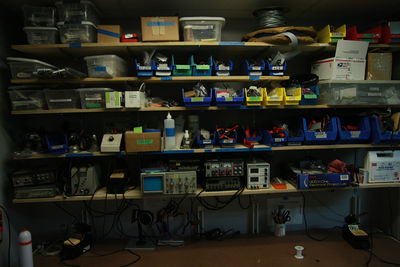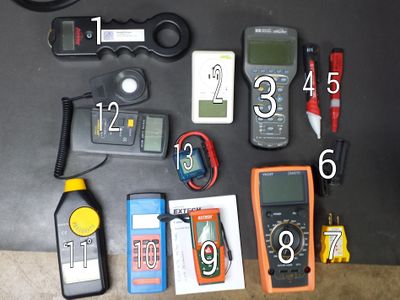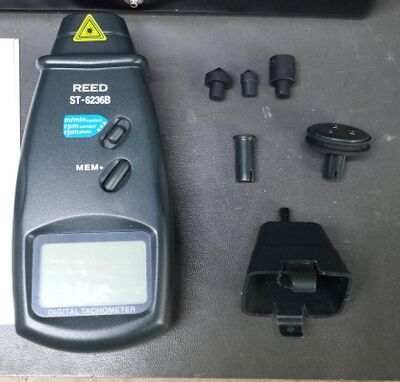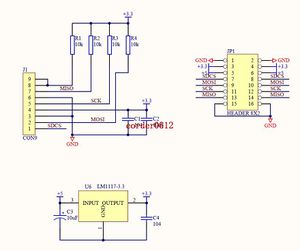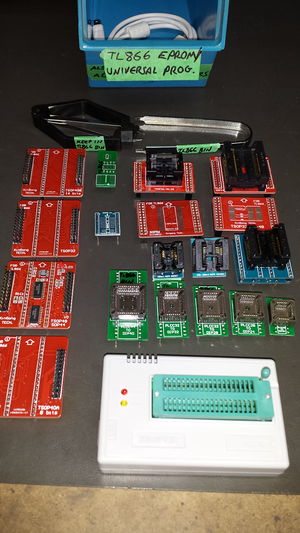Category:Electronics Lab
| Zone Information | |
|---|---|
| Zone Name | Electronics Lab |
| Status | Active |
| Zone Slogan | "Strong enough for a professional, pH-balanced for a noob." |
| Zone Committee Heads(s) | Nate Bezanson |
| Zone Slack | #elab |
| Zone E-mail | elab@i3detroit.org
|
| Zone Color | Yellow |
| Paypal Button | Pay money to Electronics Lab |
Contents
Welcome
Please leave the zone cleaner than you found it. Being able to find things again is important! When in doubt, please ask. (Or email the ZoCo, above.) We're here to help each other make cool stuff.
Philosophy and guidelines
This is yours:This is what we make it, so please help make it the best it can be.
Keep it clean:Please wipe the workbench clean as you prepare to leave. If the floor needs vacuuming, pick up the snaggy bits and start the robot!
Plethora of parts:Please reimburse for any components that leave the lab. Exception: If you're using less than a dollar worth of stuff today, don't sweat it -- just build awesome things and share them!
Component cost:Some components have their reimbursement cost labeled on them -- this is roughly what it costs us to get more. If there's nothing labeled, look it up and assume we're buying at the first price-break, then tack on a bit for shipping. If you want to be generous beyond that, awesome! That's what helps us grow.
Not hyper-organized:In-between values could be in either place. So a 20k resistor could be in the 18k or the 22k drawer, either is OK. And a SATA-to-SD adapter could be in the SATA bin or the Flash Memory bin. It's a balance between being easy to put things away, and being able to find them with a reasonable search.
Donations of components and equipment: Please ask first! (Or email the ZoCo, above.) If you can't ask, at the very least, tag the donation as such -- otherwise we may run ourselves ragged trying to figure out who lost their treasured stuff.
Approximate cost of some common components
Rather than tagging each value individually...
| Item | Price |
|---|---|
| 1/4-watt resistor: | 2c |
| 1/2-watt resistor: | 5c |
| High-wattage resistors: | Ask! |
| 3 or 5mm LED, red/green/yellow | 5c |
| 3 or 5mm LED, white or blue | 10c |
| High-power LEDs | Ask! |
| Any ceramic cap | 5c |
| Electrolytic caps | Use Mouser, or ask |
| Zener diodes, up to 1W | 10c |
| 1n4xxx diodes | 5c |
| Other diodes | Use Mouser, or ask |
| 0.100" Harwin housings, 1 position | 2c |
| 0.100" Harwin housings, 2 positions | 15c |
| 0.100" Harwin housings, 3+ positions | 25c |
| 0.100" Harwin crimp pins | 7c |
Anything else, check Octopart
Table of Equipment
| Equipment | Authorization | Owner(s) | Status |
|---|---|---|---|
| Re:load Pro | No | i3Detroit | Running |
| Schott Binocular Microscope | No | Amelia Meyer | Running |
| Soldering Station - Edsyn Loner | No | Nate Bezanson | Running |
| Flir T450sc Infrared Camera | Yes | i3Detroit | Running |
| Sparkfun 303D Hot Air Rework Station | No | Amelia Meyer | Running |
| Waveform Generator 33622A | No | i3Detroit | Running |
| Benchtop Multimeter 34461A | No | i3Detroit | Running |
| Power Supply E3631A | No | i3Detroit | Running |
| Oscilloscope Msox4154a | No | i3Detroit | Running |
| LCR Meter U1733C | No | i3Detroit | Running |
| Lightbulb load-box | No | i3Detroit | Running |
| Antenna Analyzer | No | Brad Tarratt | Running |
| Manual Impulse Sealer | No | i3Detroit | Running |
| Rigol DS1202Z-E | No | i3Detroit | Running |
| CRTU | No | i3Detroit | Running |
| TL866 Universal Programmer | No | i3Detroit | Running |
| ZebraLink Stripe Label Printer | No | i3Detroit | Running |
TODO List
The following list is an attempt to offer up suggestions of tasks that could be accomplished in the Electronics Room by people interested in helping out.
Feel free to take charge of one or more of these items as your time and expertise allow. If you have taken charge of a task, please put your name into the field next to the task.
Should you run out of time or ability to complete a task, make sure to post on the mailing list and "fail loudly". This ensures that task status is shared, and no task languishes in silent failure.
General TODOs
| Task Name | Description | Priority | Champion |
|---|---|---|---|
| Populate ToDo List | Add a list of things that are needed/wanting to be done in the eRoom. | 1 | Nate B. |
| Diagnose and repair E3631A power supply | No idea why it sometimes goes strongly negative on output 1 | 2 | ? |
| Benchview PC | Set up a (small-form-factor) PC with Windows (10?) to run the GPIB/LXI gear. Install Keysight Benchview on it and add the licenses we got for the Dream Bench instruments. | 2 | ? |
| Cabinet map | Until Partslaser is operational, an easier way to update https://www.i3detroit.org/wiki/File:NewERoomWithOverlays-output.jpg would be nice. | 2 | ? |
| wire spool rack | Design a rack that holds 3d printer filament spools, but assume each one is heavy with wire. 10 across each shelf. | ? | ? |
| tenma meter repair | Fix the sticky ammeter needle on the Tenma 72-630 PSU. Gently! | ? | ? |
| make rolling rack for HP and Sorensen PSUs | Half-rack cabinet style would be sweet. Bug Nate about parts. | 3 | ? |
| simpson microohmmeter refurb | readings aren't consistent, maybe because the internal nicad pack is missing? | 4 | Evan? |
| cull crap on topmost shelves | either side of the window, there's a bunch of stuff we never touch, that space could be better used. | 3 | Nate B. |
Equipment TODOs
| TODO | |
|---|---|
| Lightbulb load-box | Grab a photo! Add a fan and intake/exhaust grilles? |
| Re:load Pro | Find out how this works (See PDF link in "Documentation") |
| Soldering Station - Edsyn Loner |
|
Meters
(Just a copy of a post on the mailing list, feel free to pretty this section up and remove this note.)
Referring to the numbered photo:
1: "Fish" scale, 50lb or thereabouts, hook style. Often the easiest way to measure a weight or force, this thing's built tough and has been with us since the Royal Oak days. Owner: Nate B.
2: Kill-a-watt or similar plug-in AC wattmeter. We have several of these. Useful not just for load measurement ("Can this run from that extension cord?"), but also power factor, voltage sag under load, etc. Owner: Various.
3: Logic Dart. This is like a pocket oscilloscope except it doesn't do analog -- it's a multichannel logic analyzer and even disassembles a few protocols. Incredibly useful for things like async serial troubleshooting, but the probes and wires are delicate. Owner: Ted Hansen.
4 and 5: Noncontact AC "volt-sniffers". Beeps in presence of AC field, use as a first quick-check to find live wires. Never trust your life to this; always verify with an actual meter before beginning work! Owner: Various/unknown.
6: Noncontact AC volt-sniffer built into flashlight. Push button to turn on white LED, and blue/red LEDs indicate presence and relative intensity of field. Usage same as above. Owner: Nate B.
7: Three-light AC outlet tester. You know this one. Trivia: Solid-state relays (and triac-based dimmers) in their "off" state can allow enough leakage to light the neon lamps in this tester. Confusion ensues! Owner: Nate B, perhaps others, I think there are a few of these around.
8: LCR meter. That's L for inductance, C for capacitance, R for resistance. This is the cheapest of the cheap, and doesn't work on very high or very low values. Also operation if you select the wrong component type is unpredictable. Also sometimes it's just plain unstable. But it works, mostly. (A better LCR meter is also around.) Use for sorting or checking capacitors prior to use. Owner: i3.
9: Laser distance meter. Seriously consider reading the manual, this has way too many features. By default it seems to figure its own body into the length measurement, but I'm sure that's configurable if you don't want that. Surprisingly accurate. Owner: Nate B took this home.
10: Ultrasonic distance meter. Purchased before, and obsoleted by, the superior instrument above. Still somewhat useful for assessing the ultrasonic reflectivity of materials, also perhaps annoying dogs or bats. Owner: Nate B.
11: Sound pressure level meter. Uncalibrated but still useful for relative measurements, has A- and C-weighted filters. Owner: Nate B.
12: Light intensity meter. Measures in lux, can manually convert to footcandles or whatever. Supposedly weighted to human sensitivity curve but I find this claim dubious given its price. Uncalibrated, obviously. Too sensitive to measure direct sunlight; use neutral-density filters to stop it down and then adjust your math later by comparing to a known light source. Owner: Nate B.
13: Inline DC wattmeter/ammeter/hourmeter: Replacement for the similar-but-larger Watts-Up meter (which met an untimely end when its max-voltage spec was exceeded), this one has more features but seems less accurate. Anyone with ideas for calibration, have at and let me know what you find! Super handy for measuring battery charge and capacity, device load, etc. Sadly only measures in one direction so not useful as a battery coulomb-counter. Owner: Nate B.
Second photo: Three-mode tachometer. With the nose detatched, this is a photo-tach that measures reflective dots on a belt or rotating object. Snap on the nose, and it measures RPM as the spinny bit is pressed against a shaft end, with 3 different conical attachments for contact. Swap out the cone for the wheel, and it measures surface speed of a belt or whatever. Please keep all the accessories with it in the box! Oh, and RTFM before using the wheel, there's a scale factor... Owner: Nate B.
Not pictured but lives behind the other-meters bin: West Mountain Computerized Battery Analyzer III (CBA3). A computer-controlled resistive load with a calibrated ammeter, you charge the battery with your usual charger, then use this to discharge it and see how much power you got out. Software is on the CD in the box. Owner: Nate B.
Also recently joined: Simpson micro-ohmmeter, not yet set up and working; we need to make some BNC-to-Kelvin clip leads for it. And then sanity-check it with a few known low resistances. But then it's an amazing tool for measuring wires and other resistances below the range of typical multimeters. Owner: Evan?
Reference
Please feel free to edit this section and add more links!
General Design/Howto
Intermediate-to-advanced design: High speed signals and termination, BGA design, PCB antenna design, also deep dives into basics like decoupling capacitors and RC filters. https://www.youtube.com/@PhilsLab/videos
Instruments
All of W2AEW's videos are great, but especially the ones about oscilloscopes, start here: https://www.youtube.com/watch?v=SX4HGNWBe5M
Keysight Labs is surprisingly good for a corporate channel: https://www.youtube.com/user/KeysightOscilloscope
Mr Carlson's Lab especially for vacuum-tube-era repair: https://www.youtube.com/user/MrCarlsonsLab
Soldering and workmanship
Some resources I've found useful for learning soldering, for those like me that prefer a good video over reading a website:
Pace Basic Soldering Lessons: http://www.youtube.com/playlist?list=PL926EC0F1F93C1837
Pace Rework & Repair Lessons: http://www.youtube.com/playlist?list=PL958FF32927823D12
Tangent Tutorials: http://tangentsoft.net/elec/movies/
Crimping, good photos of open-barrel terminals including Metri-Pack seals: http://www.bodenzord.com/archives/590
Components and package types
TopLine component package types: http://www.topline.tv/DummyClass101.pdf
What's that? A collaboratively-edited collection of parts that hobbyists actually find useful? Yes! Behold, the Partfinder! http://www.ladyada.net/wiki/partfinder
See also Dangerous Prototypes' collection: http://dangerousprototypes.com/docs/Partlist
There's a trove of 7400-series datasheets here: http://www.skot9000.com/logic-datasheets/
And a good list of the whole series: https://en.wikipedia.org/wiki/List_of_7400-series_integrated_circuits
Gorgeous printable reference sheets: http://www.akafugu.jp/posts/resources/reference-sheet/
Nate B's oooold bookmarks on the subject are here: http://delicious.com/myself248/electronics
Connectors and hardware
Nate B's user-pages on this wiki contain a table of what thread is on that connector or fastener?.
AC plugs: StayOnline's charts for NEMA straight-blade, NEMA twistlock, IEC plugs, etc: https://www.stayonline.com/product-resources/
Wire-to-board connector and crimper info: http://www.mattmillman.com/info/crimpconnectors/
1Davide is a moderator of https://www.reddit.com/r/AskElectronics/ and got sick of answering the same connector-identification questions, so he's making a book of it: http://connectorbook.com/
Connector Manufacturers
Molex: https://www.molex.com/molex/products/group/wire_to_board_connectors
TE / AMP: https://www.te.com/usa-en/products/connectors.html
JST: http://jst.com/ check the "product selection guide" pdf and the "search by application" tree.
Sumitomo: http://prd.sws.co.jp/components/en/index.php
Hirose: https://www.hirose.com/en/product/series
Yazaki: https://connectors-catalog.sys.yzk.co.jp/english/2/pdf.html
Amphenol: https://www.amphenol.com/products/by-application/113
Zone-stuff info
Pages in category "Electronics Lab"
The following 20 pages are in this category, out of 20 total.


